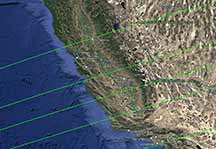
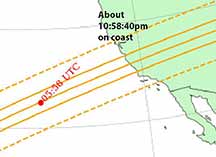
kmz file , click on link to open up GoogleEarth with path and limits. This path is the one which Jose has more confidence in, vs. some of the other paths w/o the new astrometry.
This is a high value TNO occultation, subject of a PhD thesis... José María Gómez-Limón Gallardo and I am a PhD student at IAA-CSIC in Granada, Spain. This email is to inform you about the TNO 2012 YF12 occultation opportunity that will be visible from Hawaii and USA West Coast on 2025-04-10T05:57 UTC, see attached files. This is a target of my thesis project. Since I am targeting smaller and hence fainter targets, the uncertainty region was originally higher than usual. However, the use of VLT high precision astrometric data allowed us to considerably narrow down the shadow path.
The aim of the campaign is to get at least one positive detection so that the ephemeris of the object can be further refined. Since the object is embedded in a dense stellar field, new occultation opportunities will arise (and this time with smaller uncertainty and greater chances for more positive chords).
If it is possible for you to observe this event, the data would be of GREAT value for my research. The attachment pdf document has more details to prepare your observation. Please report your intention to observe preferentially through the Tubitak occ portal https://occultation.trgozlemevleri.gov.tr/ or occultwatcher website, as I will be monitoring those. For any further questions do not hesitate to contact me. In order to streamline the analysis process, I kindly request that you provide your data in FITs images when you can (CMOS, CCDs), video is ok for video cameras. To make this process as smooth as possible, you can upload your data to the Occultation Portal used by our Lucky Star collaboration ( https://occultation.trgozlemevleri.gov.tr/ ). Include dark and flat calibrations in your data when possible. If you are new to this portal or have not used it for a long time, here (https://occultation.trgozlemevleri.gov.tr/media/docs/Quickguide_OccultationPortal.pdf ) you have the quickguide on how to use it
 |
 |
Alt=17.5 Az=256 in Monoceros about 13 degrees due left of Betelgeuse. Max duration = 12.3 seconds
The moon is 75 degrees away and 93% big, so the sky will be bright and with low altitude, even brighter. This is a tough event and we may not be able to preserve sky contrast when we get to a high enough integration. What may help is to take out the focal reducer. I don't think lowering the gamma will help, in a bright sky it'll just make it worse.
I set up at the cul-de-sac of Pine Ridge Rd in Bonny Doon. During the event time, the sky over the target was pretty clear, otherwise significant cirrus around the sky. Low alt=17 deg and 93% moon made for bright sky. I integrated at 64x as a compromise. I could see the star on nearly all the 1-sec integrations. I removed the f/3.3 reducer to lower sky brightness, and the drift of the scope was a problem. PyMovie lot tracking on each of the moves of the scope, no matter how small. However, I did get about a solid minute including the predicted time, when tracking on star was OK. A suspected occultation at 10:58:44 lasting only perhaps 2-3 seconds, but low confidence, and Kirk Bender only a transverse distance of a mile or so away, saw nothing at 128x at that time. Probable noisy miss.
My PyMovie OCR's were contaminated by the very bright star seen in the finder. However, there were no dropped frames, and by using 'manual time insertion' in PyOTE I will be able to recover the time stamps for all frames. I will use the 'finder' feature to look separately at each integration's 32 frames and damp out sky noise and see if either of my dips might be more convincing. Not done yet as of 4/12/25.
|
A 'fourier finder' stack of 77 frames beginning at 5:57:02 UT, showing the target star, and how the OCR'ing of the times was contaminated at times by the very bright star at bottom. |
Play back on Windows Media Player and a stop, and screen capture, 10s after the drop point seen in my PyMovie data. |
Playback on Windows Media Player and a stop and screen capture at the dip in my light curve at 5:58:44 UT, un-enhanced just as image at left. No target star seen. |
Same screen capture, but using Photoshop 'curves' and AstronomyTools "Local contrast enhance" to amplify any faint trace of the target star, but none is seen. |
Let's do a whole sequence of 64 frame 'finder stacks'. 64 frames is 2x the integration rate, The finders are definitely quieter in sky background noise. 64 frames x 2/50s per frame = 2.56 s per finder, The integration rate was 1.28s per integration in the Watec 910hx. So by starting my finders at 1s intervals there will be overlap from one image finder to the next, below. Hence the satellite crossing shows on both of the first two images for example. Here is the image sequence. The time stamp put onto the image at the start of the finder stack is what is on the image itself. Since the output time is actually applied at the END of the integration, it's a little confusing as to what is the representative time at the middle of these finders. From 5:58:39 to 5:58:49 UT. The target is definitely there at the beginning and the end of this sequence, but not so clearly there in the middle... I didn't do any post-processing of the finder images to change contrast or levels, as that would obscure the effects of any clouds that may have come through. The target appears to be missing from the 5:58:44.225 image and the 5:58:45.225 image, and faintly back in the 5:58:46.225 image. Suggesting a 2-3 s event. We were nominally north of the predicted line, but if there was an event for me, that would indicate the path just nicked me on the south side of the shadow, not the north side, since Kirk's data did not have a hint of this. 3km separation is pretty small and would indicate the shadow path was at Kirk's track. But that's a lot of supposition at this point. Roger Venable has volunteered to run it through LiMovie updated, and see what he can see.
 |
 |
 |
 |
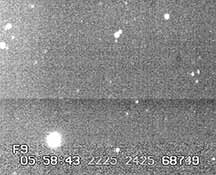 |
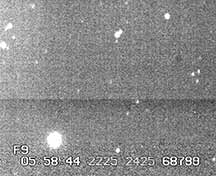 |
 |
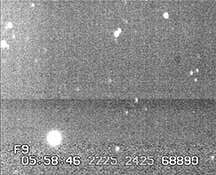 |
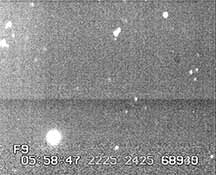 |
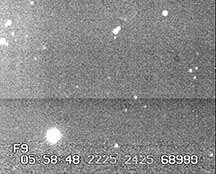 |
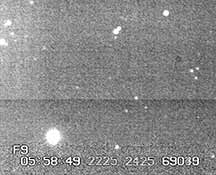 |
Observed from "the Berm" on Empire Grade in Bonny Doon, 3km south of my station at Pine Ridge Rd. He observed at 128x on his Watec 910hx EIA with IOTA VTI, 8SE telescope at f/3.3.
I don't see an event in my data, but at 128x it is very chunky. I don't see a drop at 5:58:45 like yours. I did use the f 3.3 reducer. I was adjusting gain, etc. and started perhaps later than I should have, at 5:57:26, but I recorded for 3 min 40 sec, so at 128x I could get more points for a noise baseline. In pymovie I did a TME and a nest of several static apertures. attached are graphs, Pyote1 is not block integrated, the apertures are from TME at the bottom, then static 2.0 to 5.1 then a reference star at the top. Red dot on the left is at predicted 5:58:30, dot on the right is 5:58:45. Pyote2 is block integrated, unsmoothed. Pyote3 is no-star at the bottom, then aperture size 2.4 smoothed, then reference star. The detectability test said: "An event of duration 4.300 seconds with magDrop: 8.0 is likely detectable." (Max predicted was 12.32) Doesn't look like there's any event, but I had pyote try to find one anyway, and it didn't find any, just gave the message:"No event fitting search criteria could be found." This is specifying min/max of 2/10 or 2/5. So doesn't look like an event, but prediction wasn't very precise, and we very well could have got a miss. I'll upload my recording to the Lucky Star portal anyway, and let them examine it. I did take a dark frame at the time. Too cloudy this evening to take a uniform twilight flat.